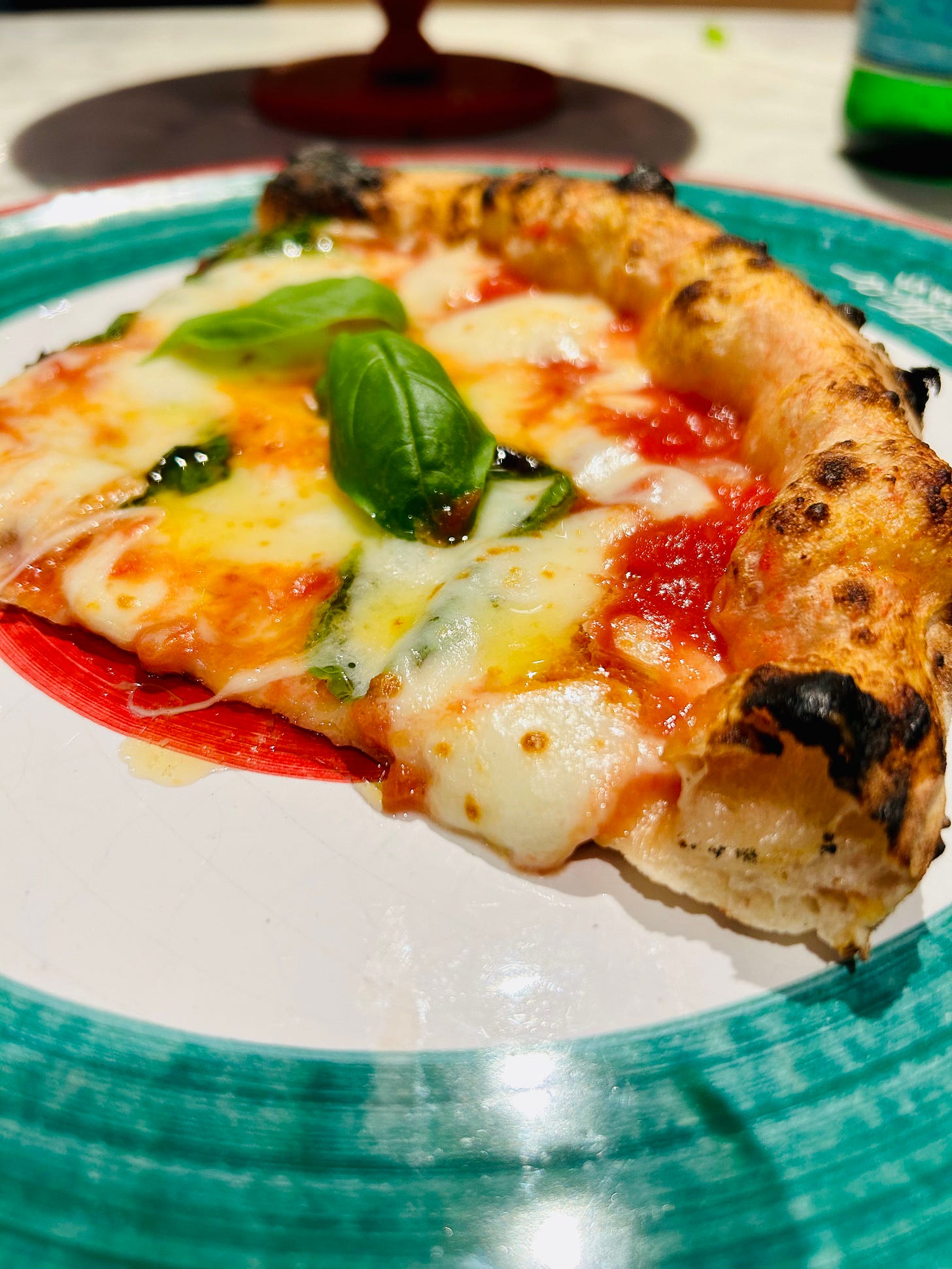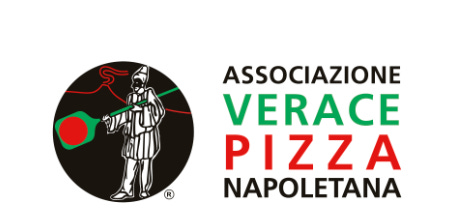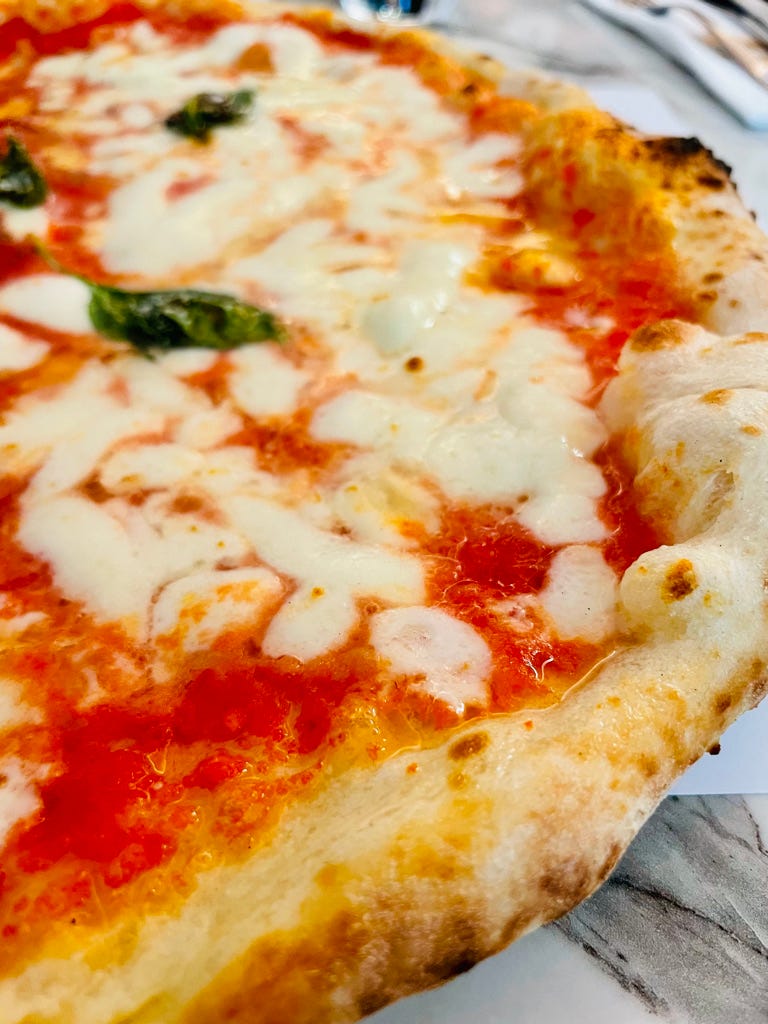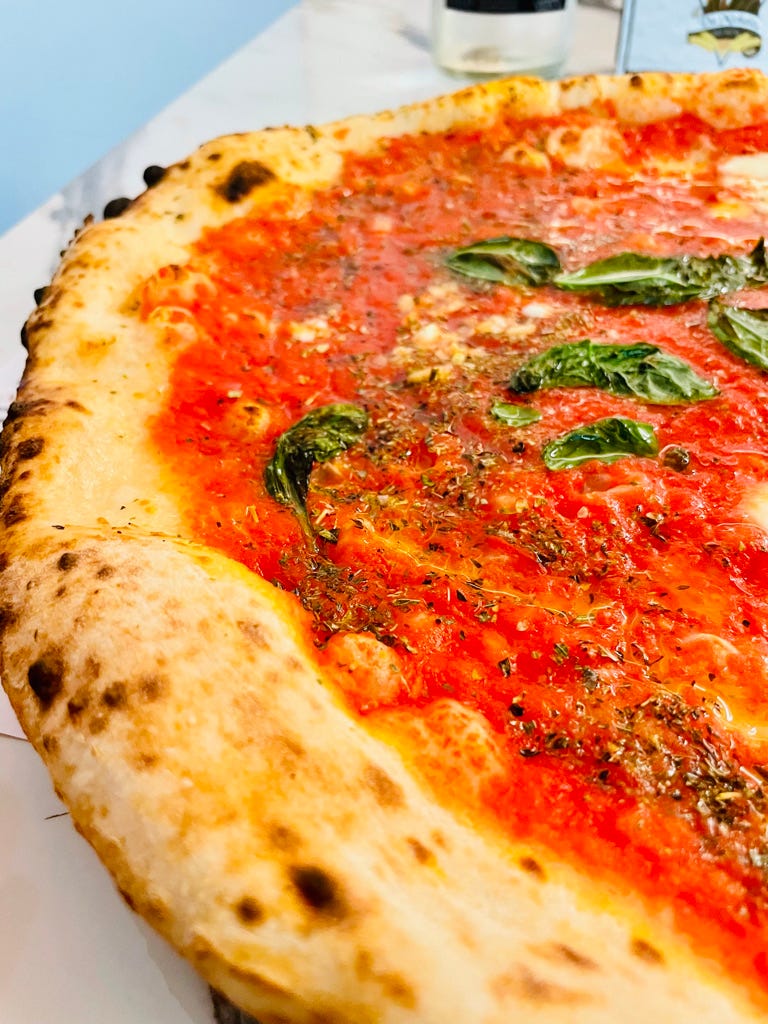Pizza Chronicles - How much do you know about Neapolitan Pizza?
Dipping my toes into the "cornicione" universe
This is a picture of probably the best slice of pizza Margherita I have ever eaten!
It was made for me two weeks ago by the trustworthy hands of the “pizzaiolo” of legendary pizzeria Concettina Ai Tre Santi in Naples.
It had the most perfect balance of soft and delicate dough, with a gentle crunchy char of the wood oven, tangy tomato, creamy salty and dense mozzarella, basil so fresh that it actually was alive until a minute before it landed on my pizza, as part of a potted plant on my table! It was an incredibly balanced mouthful, where each ingredient burst into my mouth leaving a very satisfactory sensation…and I immediately craved for more!
Yes I admit it, I am quite obsessed with pizza! With eating it, trying to make it, understanding it and discovering all the different styles that exist throughout Italy and the rest of the world. That’s the reason why I started a series on my Substack called pizza chronicles, where I will discuss and analyse doughs and slices, shed some light on some of the histories and myths around Italian pizza, and share some of my favourite pizza places.
You probably all know that pizza, one of the most singlehandedly beloved and popular foods worldwide was born in Naples, but do you know much about what pizza looks like in Naples nowadays and what makes it different from pizza in the rest of Italy?
My family is from Sicily and I grew up in Torino, and I can tell you for a fact that when I was a kid pizza didn’t look like the picture here above, neither in Turin, nor in Sicily. Most pizza in the average pizzeria in the north of Italy was very thin, rather large and the dough was quite crunchy. It was what most Italians would call to this day Roman style pizza (not to be confused with Roman tray style pizza). We will get into the historical reasons of why that was in another related post.
Nowadays, what is referred to as “pizza Napoletana” is present everywhere along the peninsula and it appears to be popular abroad as well.
So it is not uncommon, when you are outside of Campania (the region in which Naples is), to hear people discussing a pizzeria by saying “Is it Neapolitan or Roman style?”
So what does it actually mean? What is Neapolitan style pizza and why is it different from most pizzas worldwide? (considering they invented it!).
It’s a tricky question to answer, and it will take many posts to try tackle it but let’s start by looking at what it takes to make a pizza these days and be able to call it “Pizza Napoletana”.
Neapolitans are very precise about this, so precise that in 2004 they registered a document to discuss what can be called “Pizza verace Napoletana” (True Neapolitan pizza). Interestingly enough this document is called “Disciplinare”, (for all those that need to be disciplined into the art of making pizza!)
On their website you can download the pdf document with incredibly precise rules and details concerning allowed flours, hydration, toppings, cooking method etc..
It gets so precise that it even discusses the hand motion while adding oil to the pizza before it goes into the oven!
Feel free to get stuck into the rules and regulations if you are a pizza nerd, but honestly, whenever I see official registered recipes, I become a bit skeptical.
You will hear me saying over and over again that Italian food comes from oral traditions, and in a similar way to music, it’s in constant flux, motion and development. Whenever you try to fix and “academise” a folk tradition, you literally make it die!
This is very true for Neapolitan pizza as well, and I can tell you two things:
1. This is not how pizza looked in the 19th century in Naples (more on that later with facts in hand).
2. During my last visit to Naples, I had at least 5 completely different types of pizza, and all of them were unequivocally “Pizze Napoletane”.
I will dig deeper into those styles old and new in future posts, but for now I will tell you what my impressions and experiences are when it comes to the most classic pizza Napoletana.
If you think pizza should always be crunchy and thin, or bubbly and airy, then you’re not going to love Neapolitan pizza dough. All the pizze I had in Naples had very soft dough…in fact I heard people commenting on how good a pizza was by saying the crust was super soft, almost melt in your mouth!
Neapolitan dough is thin, super soft and with a quite big side crust (called cornicione), which is also still soft and quite spongy. The dough has to be soft to act as a vessel when folded to contain the toppings.
Even when pizza is served at the table, most people cut it into four slices (if not into two!!) and then pick up a 1 quarter of the pizza and fold it in two to eat it. This seems to be the only way to eat this style of pizza. If you make smaller slices all the toppings fall off as the bottom is too soft and thin and the tip doesn’t hold the weight of the toppings. Contrary to what Anthony Bourdain said in one of his documentaries, where he stated everyone eats pizza with cutlery in Naples, I have observed the majority of people eat with their hands! It is totally possible if you know how to do it.
For some reason this reminded me a bit of how you are supposed to eat tacos. I was told many times by Mexicans that you should hold a taco horizontally and “bow” to it sideways so that when you bite from the side, the contents do not fall all over the table…or you clothes! Taco is king, so you bow to it!
So I dare say, Pizza is queen (the name Margherita was created in honour of regina Margherita di Savoia), and as much as i’m against monarchy, you should bow to it as well! It will make it a much easier operation and it will keep the toppings inside your pizza.
The dough is traditionally a quite low hydration (around 60%), it’s religiously stretched by hand with a technique called “schiaffo”, the slap, and it’s cooked in incredibly hot wood ovens for 60-90 seconds. You would never use a rolling pin as you would not be able to create that big pillowy “cornicione” with it.
When it comes to toppings, tradition asks for hand crushed pomodori pelati San Marzano, a local variety that grows in the grounds surrounding the Vesuvio (but not on the volcano itself).
I am gonna open a short parenthesis here about tomatoes and sauce. I promise I will dedicate many posts to this subject later! Many people outside of Italy do not understand that Italian pizza does not have cooked tomato sauce on it. In Naples it’s literally hand crushed pomodori pelati, dressed with oil and salt. They only get a 60 seconds blast in the hot wood oven on top of the pizza…that’s it!
It is most definitely not Nonna’s sunday sauce cooked for hours on the stovetop.
The cheese should be fiordilatte, either in slices or large strips. This creates many individual “stains” of white cheese as opposed to a more evenly shredded cheese topping on a NY slice. I personally love the fact that fiordilatte is treated as an individual ingredient and not as a general canvas (like the tomato sauce is). The cheese has so much flavour and it’s not equally present in every single bite but creates a beautiful chiaroscuro alternation with the acidity of the tomatoes.
The rules allow for Mozzarella di Bufala as well but most Neapolitans will swear it’s not real pizza if it doesn’t have fiordilatte.
Here another small parenthesis as I need to explain that Neapolitans call “fiordilatte” what most of the world calls mozzarella. When Neapolitans say mozzarella they refer to buffalo mozzarella.
In reality the two cheeses have similar procedures but very different results.
Fiordilatte is made with cow’s milk and Mozzarella di Bufala is made with Buffalo milk. The type of milk changes radically the flavour profile and consistency of the cheese, and most people will agree that Buffalo mozzarella doesn’t quite express its full potential when cooked, and should always be eaten raw.
Other final defining features of Pizza Napoletana are fresh basil or oregano, a drizzle of olive oil and often a little bit of grated parmigiano or pecorino
The two most classic flavours of pizza are:
Margherita:
Tomatoes, fiordilatte or buffalo mozzarella, basil, parmigiano or pecorino (not obligatory), oil
Marinara:
Tomatoes, thin slices of garlic, oregano, oil and possibly a few basil leaves
Finally the pizza needs to be cooked in a wood oven for 60-90 seconds and a temperature of 485 degrees celsius (905 F)
Pizza Napoletana needs to be eaten immediately after it comes out of the oven, as after only 5 minutes it goes cold and tends to become rubbery.
It is always simple in topping combinations. Like most Italian foods, the focus is on the quality of the very few local ingredients that make it, not the quantity!
It’s an incredibly balanced mouthfeel that allows each ingredient to shine and it’s so incredibly delicious!
Did you ever have Pizza Napoletana? Do you like it? Let me know your thoughts in the comment section.
(p.s. I know in the US people refer often to Neapolitan or Sicilian pizza. Those particular styles are very different to the ones you find in Italy nowadays, but that’s subject for other future posts).









This was so much fun! thank you thank you thank you. I can’t wait to read what you write next. Lining up to be a paid subscriber.
I went to college in New Haven, CT, where they claim to have invented pizza. Obviously a myth, but it seems like this is the main style of pizza the great pizza spots there were serving.